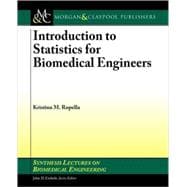
Note: Supplemental materials are not guaranteed with Rental or Used book purchases.
Purchase Benefits
Looking to rent a book? Rent Introduction to Statistics for Biomedical Engineers [ISBN: 9781598291964] for the semester, quarter, and short term or search our site for other textbooks by Ropella, Kristina M.. Renting a textbook can save you up to 90% from the cost of buying.
| Introduction | p. 1 |
| Collecting Data and Experimental Design | p. 5 |
| Data Summary and Descriptive Statistics | p. 9 |
| Why Do We Collect Data? | p. 9 |
| Why Do We Need Statistics? | p. 9 |
| What Questions Do We Hope to Address With Our Statistical Analysis? | p. 10 |
| How Do We Graphically Summarize Data? | p. 11 |
| Scatterplots | p. 11 |
| Time Series | p. 11 |
| Box-and-Whisker Plots | p. 12 |
| Histogram | p. 13 |
| General Approach to Statistical Analysis | p. 17 |
| Descriptive Statistics | p. 20 |
| Measures of Central Tendency | p. 21 |
| Measures of Variability | p. 22 |
| Assuming a Probability Model From the Sample Data | p. 25 |
| The Standard Normal Distribution | p. 29 |
| The Normal Distribution and Sample Mean | p. 32 |
| Confidence Interval for the Sample Mean | p. 33 |
| The t Distribution | p. 36 |
| Confidence Interval Using t Distribution | p. 38 |
| Statistical Inference | p. 41 |
| Comparison of Population Means | p. 41 |
| The t Test | p. 42 |
| Hypothesis Testing | p. 42 |
| Applying the t Test | p. 43 |
| Unpaired t Test | p. 44 |
| Paired t Test | p. 49 |
| Example of a Biomedical Engineering Challenge | p. 50 |
| Comparison of Two Variances | p. 54 |
| Comparison of Three or More Population Means | p. 59 |
| One-Factor Experiments | p. 60 |
| Example of Biomedical Engineering Challenge | p. 60 |
| Two-Factor Experiments | p. 69 |
| Tukey's Multiple Comparison Procedure | p. 73 |
| Linear Regression and Correlation Analysis | p. 75 |
| Power Analysis and Sample Size | p. 81 |
| Power of a Test | p. 82 |
| Power Tests to Determine Sample Size | p. 83 |
| Just the Beginning | p. 87 |
| Bibliography | p. 91 |
| Author Biography | p. 93 |
| Table of Contents provided by Ingram. All Rights Reserved. |
The New copy of this book will include any supplemental materials advertised. Please check the title of the book to determine if it should include any access cards, study guides, lab manuals, CDs, etc.
The Used, Rental and eBook copies of this book are not guaranteed to include any supplemental materials. Typically, only the book itself is included. This is true even if the title states it includes any access cards, study guides, lab manuals, CDs, etc.